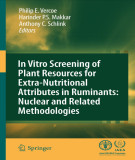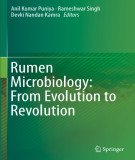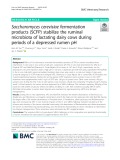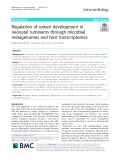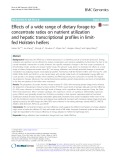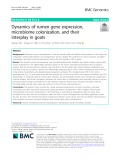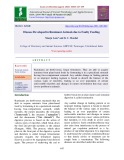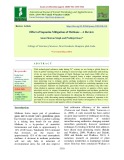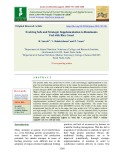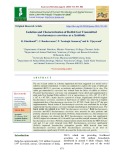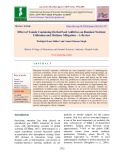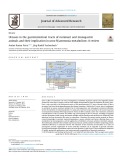
Ruminal fermentation
-
Ebook "In vitro screening of plant resources for extra-nutritional attributes in ruminants: Nuclear and related methodologies" is to provide a comprehensive guide to the methods involved in collecting, preparing and screening plants for bioactive properties for manipulating key ruminal fermentation pathways and against gastrointestinal pathogens.
 252p
252p  tachieuhoa
tachieuhoa
 28-01-2024
28-01-2024
 3
3
 2
2
 Download
Download
-
Part 2 book "Rumen microbiology - From evolution to revolution" includes content: Plant secondary metabolites; microbial feed additives; utilization of organic acids to manipulate ruminal fermentation and improve ruminant productivity; selective inhibition of harmful rumen microbes; ‘omics’ approaches to understand and manipulate rumen microbial function; acidosis in cattle, urea ammonia metabolism in the rumen and toxicity in ruminants, nitrate nitrite toxicity and possibilities of their use in ruminant diet,... and other contents.
 214p
214p  muasambanhan01
muasambanhan01
 13-12-2023
13-12-2023
 6
6
 3
3
 Download
Download
-
Part 1 book "Rumenology" includes content: Anatomy and physiology of the rumen, microbiology of the rumen, ruminal fermentation, lipid metabolism in the rumen, ruminal acidosis.
 172p
172p  oursky05
oursky05
 20-09-2023
20-09-2023
 3
3
 1
1
 Download
Download
-
Part 2 book "Rumenology" includes content: Uminal fermentation, lipid metabolism, use of virginiamycin in cattle feeding, grain processing for beef cattle, net nutrient flux across the portal drained viscera and liver of ruminants, rumen models, planning and analyzing digestibility experiments.
 154p
154p  oursky05
oursky05
 20-09-2023
20-09-2023
 3
3
 1
1
 Download
Download
-
Good quality protein as an on-farm feed resource has been in great demand to support the productivity of ruminants. A digestion trial using beef cattle crossbreds was conducted to assess the four dietary treatments of Flemingia macrophylla silage (FMS) supplementation at 0, 0.2, 0.4 and 0.6 kg dry matter (DM)/day in a 4 × 4 Latin square design.
 7p
7p  vidarwin
vidarwin
 23-02-2022
23-02-2022
 13
13
 1
1
 Download
Download
-
Effects of Saccharomyces cerevisiae fermentation products (SCFP) on rumen microbiota were determined in vitro and in vivo under a high and a depressed pH. The in vitro trial determined the effects of Original XPC and NutriTek (Diamond V, Cedar Rapids, IA) at doses of 1.67 and 2.33 g/L, respectively, on the abundances of rumen bacteria under a high pH (> 6.3) and a depressed pH (5.8–6.0) using quantitative PCR (qPCR).
 17p
17p  vigandhi
vigandhi
 23-02-2022
23-02-2022
 10
10
 1
1
 Download
Download
-
In ruminants, early rumen development is vital for efficient fermentation that converts plant materials to human edible food such as milk and meat. Here, we investigate the extent and functional basis of host-microbial interactions regulating rumen development during the first 6 weeks of life.
 16p
16p  vielonmusk
vielonmusk
 30-01-2022
30-01-2022
 16
16
 0
0
 Download
Download
-
The transition from a high forage to a highly fermentable diet can induce digestive disorders in the rumen. To date, the host mechanisms that regulate the adaption to such dietary transition are largely unknown. To understand the molecular mechanisms involved in such phenomena, RNA-sequencing was performed to identify the changes in the transcriptome of ruminal epithelia during gradual transition from a diet containing 0% to 89% grain.
 17p
17p  vilarryellison
vilarryellison
 29-10-2021
29-10-2021
 4
4
 0
0
 Download
Download
-
Liver biopsy samples were obtained and RNA sequencing was conducted to identify the hepatic transcriptomic changes. Moreover, the ruminal fermentation profiles, growth characteristics, and levels of metabolites in the liver and plasma of the heifers were monitored.
 16p
16p  vibeauty
vibeauty
 23-10-2021
23-10-2021
 13
13
 0
0
 Download
Download
-
Preweaned rumen development is vital for animal health and efficient fermentation. In this study, we integrated ruminal transcriptomic and metagenomic data to explore the dynamics of rumen functions, microbial colonization, and their functional interactions during the first 8 weeks of life in goats.
 15p
15p  vilichoo2711
vilichoo2711
 23-06-2021
23-06-2021
 7
7
 1
1
 Download
Download
-
Ruminants are herbivorous, forgot fermentors. They are able to acquire nutrients from plant based foods by fermenting it in a specialized stomach having four-compartment stomach. Any sudden change in feeding pattern or an improper feeding regimen is bound to disturb the balance of the various types of microbes, leading to an over population of certain unfavorable microbes and changes in rumen environment that may cause severe problem in animals.
 13p
13p  trinhthamhodang11
trinhthamhodang11
 27-04-2021
27-04-2021
 14
14
 2
2
 Download
Download
-
Farmed ruminants form a very large portion of total anthropogenic methane emissions globally. Methanogens present in ruminal flora primarily uses Hydrogen [H] produced during anaerobic carbohydrate fermentation. Ruminal microflora can convert plant fiber unavailable for humans into microbial protein available for absorption for ruminants with biological value 70.
 15p
15p  nguaconbaynhay7
nguaconbaynhay7
 15-08-2020
15-08-2020
 15
15
 2
2
 Download
Download
-
B vitamin supplementation in ruminants is ignored conventionally following an earlier observation that they are synthesized in adequate quantities in the rumen by rumen microbes. Recent researchers reported that major cellulolytic organisms in the rumen had specific requirements for certain B vitamins. Apart from the requirements of the rumen microbes, high producing cattle also require a higher amount of vitamins to maintain their productivity and health. Sub-clinical vitamin deficiencies often go unnoticed due to the lack of proper clinical symptoms.
 5p
5p  nguaconbaynhay5
nguaconbaynhay5
 16-05-2020
16-05-2020
 13
13
 1
1
 Download
Download
-
The present study was carried out to evolve a safe and strategic supplementation to rice gruel by synchronizing nutrient delivery in the rumen for maximum microbial production. Three in vitro trials were conducted to study the rumen fermentation characteristics of nonprotein nitrogen (NPN) and sulphur sources supplementation to rice gruel with basal diet (Bajra x Napier grass, CO4). Urea and diammonium phosphate (DAP) were used as NPN sources, while copper sulphate and sodium sulphate were used as sulphur sources.
 9p
9p  kequaidan4
kequaidan4
 05-05-2020
05-05-2020
 9
9
 0
0
 Download
Download
-
The use of yeast culture as a dietary supplement has been suggested as a useful tool to stabilize ruminal fermentation. A study was conducted to explore the scope of rabbit gut transmitted (RGT) S. cerevisiae as probiotic and prebiotic (Synbiotic) by in vitro. The rabbit gut transmitted S. cerevisiae was isolated from the faeces of rabbits as follows.
 12p
12p  quenchua4
quenchua4
 06-04-2020
06-04-2020
 6
6
 0
0
 Download
Download
-
Ruminant livestock constitute worldwide the most important source of anthropogenic emissions of methane. There are two main factors influencing global warming change, an increase in greenhouse gas emissions and depletion of the ozone layer. Methane is associated with both factors. Ruminants (dairy, beef, goats, and sheep) are the main contributors to CH4 production. Their CH4 production is a natural and inevitable outcome of rumen fermentation.
 10p
10p  trinhthamhodang4
trinhthamhodang4
 22-03-2020
22-03-2020
 18
18
 0
0
 Download
Download
-
Urea in diets of ruminants has been investigated to substitute expensive animal and vegetable protein sources for more than a century, and has been widely incorporated in diets of ruminants for many years. Urea is also recycled to the fermentative parts of the gastrointestinal (GI) tracts through saliva or direct secretory flux from blood depending upon the dietary situations. Within the GI tracts, urea is hydrolyzed to ammonia by urease enzymes produced by GI microorganisms and subsequent ammonia utilization serves the synthesis of microbial protein.
 12p
12p  trinhthamhodang1
trinhthamhodang1
 14-11-2019
14-11-2019
 13
13
 0
0
 Download
Download
-
The characteristic feature of ruminants is the fermentative nature of their digestion. This feature of their digestive system allows them to survive on high-fibre diets (Leng, 1970). The principal products of fermentation of dietary fibre are short-chain fatty acids....
 54p
54p  lequanghoang15
lequanghoang15
 24-08-2010
24-08-2010
 90
90
 9
9
 Download
Download
-
Rumen fermentation is an exergonic process that converts feedstuffs to short-chain volatile fatty acids (VFA), methane, ammonia and occasionally lactic acid. Some of the free energy is used to drive microbial growth, but heat is also evolved. The efficiency of rumen microbial growth can have a profound effect on animal performance....
 34p
34p  lequanghoang15
lequanghoang15
 24-08-2010
24-08-2010
 74
74
 8
8
 Download
Download
-
Volatile fatty acids (VFAs), principally acetate, propionate and butyrate but also lesser amounts of valerate, caproate, isobutyrate, isovalerate, 2-methylbutyrate and traces of various higher acids, are produced in the rumen as end-products of microbial fermentation....
 50p
50p  lequanghoang15
lequanghoang15
 24-08-2010
24-08-2010
 88
88
 7
7
 Download
Download
CHỦ ĐỀ BẠN MUỐN TÌM








